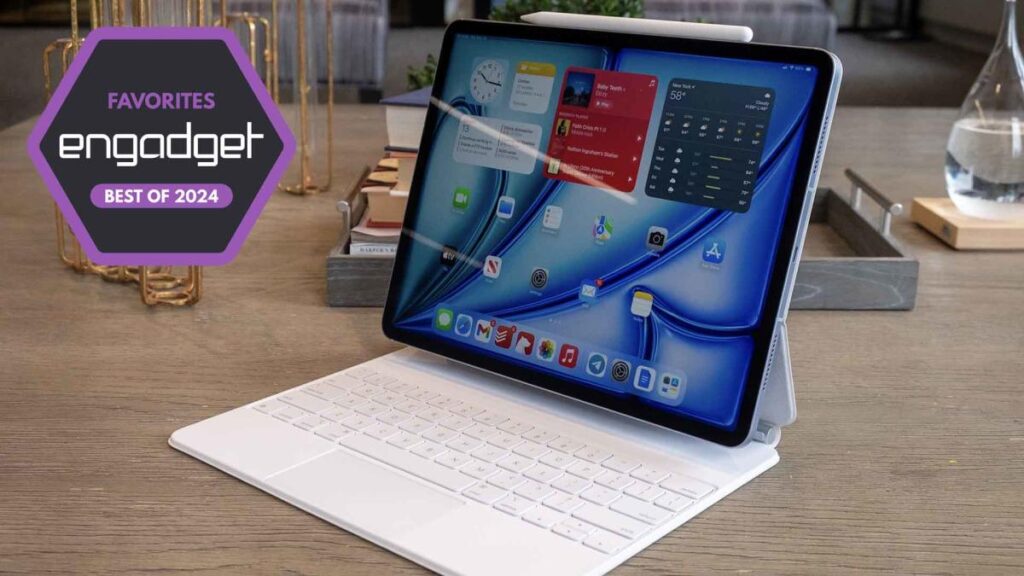Screen size: 11 inches or 13 inches | Display resolution: 2420 x 1668 (11 inches), 2752 x 2064 (13 inches) | Storage: Up to 2TB | Ram: Up to 16GB | Weight: 0.98 lbs (11 inches), 1.28 lbs (13 inches) | Battery life: Up to 10 hours | Front camera: 12MP | Back camera: 12MP
Read the full story Apple iPad Pro (M4) review
The latest iPad Pro is more tablet than most people need. But if you have cash to spend, are determined to use your iPad as your primary mobile computer, or just want the most technologically advanced iPad, this is the one for you.
We gave the new iPad Pro an 84 score in our review. Like the iPad Air, it comes in 11-inch and 13-inch models, with the former starting at $999 and the latter starting at $1,299. That’s prohibitively expensive for most people, but for that money you get more premium upgrades than Apple’s other tablets, even if they aren’t essential.
Chief among these is the Pro’s “tandem OLED” panel. You get richer colors and deeper, more even black tones compared to the iPad Air’s LCD screen. A fast 120Hz refresh rate makes scrolling games and web pages look smoother. It’s also significantly brighter, reaching up to 1,000 nits for SDR and 1,600 nits for HDR highlights.
This is where the “tandem” part comes into play. Essentially, Apple stacks two OLED panels on top of each other to improve peak brightness, a (relative) weakness of traditional OLED displays. This is groundbreaking, but what you really need to know is that this screen is absolutely fun. This is one of the best I’ve ever seen on any consumer device, let alone a tablet. When it comes to watching movies and editing media, you can’t do better than this. Unlike previous generations, this same display technology is used in both the 11-inch and 13-inch iPad Pro models, so which one is best comes down to personal preference.
The Pro’s design is similar to the iPad Air, but it’s slightly thinner and lighter. On paper, the difference isn’t that big, but the Pro’s slimmer frame makes it just a little bit easier to hold. This is especially true for 13-inch models.
Another notable upgrade is Apple’s new M4 SoC, which is currently only available on the new Pro. If the M2 is overkill for most casual and pro-level iPad tasks, the M4 is extremely powerful. It easily chewed through anything we threw at it. But it should be even more future-proof, and if your work involves things like high-resolution media editing or heavy use of machine learning, it might save you a few seconds here and there.
Additionally, the base iPad Pro has 256GB of storage, which is twice as much as the iPad Air. It also supports more advanced features such as hardware-accelerated ray tracing on the GPU. This could help with future game writing, and a faster neural engine should help with the AI features Apple has planned in the coming months and years.
If you Really For maximum performance, the 1TB and 2TB configurations come with twice the RAM (16GB) and use a technically more powerful version of M4 with additional performance cores unlocked. Please note that. To jump to one of these SKUs, minimum However, it costs $1,599. This is before adding any accessories. This isn’t necessary for anyone who wants to use the iPad Pro as a (very expensive) media consumption device. Keep in mind that if you want to use memory-intensive apps, or if you want the absolute best apps, it will cost you money.
The iPad Pro is the only iPad with Face ID, but it’s still a little more convenient than reaching for the fingerprint scanner. It’s the only port with a Thunderbolt USB-C port, which is technically faster for transferring large files. It has four built-in speakers instead of two, which means it has more robust sound than the Air. There’s not much difference in the camera system, but it now has a flash for easier scanning of documents, and can record video in Apple’s ProRes format. The front camera is also on the long side. As for accessories, the Pro alone allows you to use Apple’s latest Magic Keyboard. It’s quite expensive in itself, but it has a higher-grade aluminum finish, a wider trackpad, and a set of function keys. It also supports the Pencil Pro stylus (but not the 2nd generation Pencil).
Most of these features may sound niche, but yeah, that’s the idea. Unless you’re willing to pay for that awesome OLED display, the iPad Air comes close enough at a more affordable price. The iPad Pro is a class-leading tablet, but it’s still an iPad after all. Some creative professionals will have no problem using it as a laptop replacement, but for most people, iPadOS still makes multitasking and other computer-related tasks more complicated than on a MacBook. Judging by the features, Apple has announced its next big iPadOS update, and that won’t change anytime soon. (The most notable addition is the new Calculator app.) That said, the Pro is a great iPad: fast, slim, and classy. And expensive.


